Library of Congress's Blog, page 133
March 31, 2016
Remember the Ladies
“I long to hear that you have declared an independency. And, by the way, in the new code of laws which I suppose it will be necessary for you to make, I desire you would remember the ladies and be more generous and favorable to them than your ancestors. Do not put such unlimited power into the hands of the husbands. Remember, all men would be tyrants if they could. If particular care and attention is not paid to the ladies, we are determined to foment a rebellion, and will not hold ourselves bound by any laws in which we have no voice or representation.”
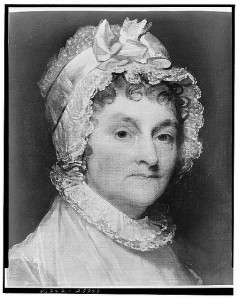
Abigail Adams. Prints and Photographs Division.
Abigail Adams wrote these words to her husband, John Adams, on March 31, 1776, nearly 150 years before the House of Representatives voted to pass the 19th Amendment giving women the right to vote. Her words urged him and the other members of the Continental Congress to consider the rights of women while laying the framework for the new, independent nation.
Abigail Adams was an advocate for greater political rights for women, especially in regards to divorce and property ownership. While her husband didn’t heed her advice then, he did consider her his better half. The two exchanged countless letters discussing everyday life and his political work, although wrote John, “as to what passes in Congress I am tied fast by my honour to communicate nothing.”
The two were married for 54 years, and their marriage was one of mutual respect and affection. Adams died in 1818, eight years before her husband. Her obituary read, “Possessing, at every period of life, the unlimited confidence, as well as affection of her husband, she was admitted, at all times, to share largely of his thoughts. … she was a friend, whom it was his delight to consult in every perplexity of public affairs; and whose councils never failed to partake of that happy harmony, which prevailed in her character; in which intuitive judgment was blended with consummate prudence; the spirit of conciliation, with the spirit of her station, and the refinement of her sex. In the storm, as well as on the smooth sea of life, her virtues were ever the object of his trust and veneration.”

Equal Franchise Society reproduces extract from famous Abigal Adams letter of March 31, 1776 in which she warns John to “Remember the Ladies.” Rare Book and Special Collections Division.
The Library’s collections contain a wide variety of resources related to John and Abigail Adams and his contributions to the nation. This resource guide compiles links to digital materials related such as manuscripts, letters, broadsides, government documents and images that are available throughout the Library of Congress website.
In addition, the Library is home to the National American Woman Suffrage Association Collection along with the papers of suffrage movement leaders like Susan B. Anthony and Carrie Chapman Catt. Even more resources can be found on the Library’s Women’s History Month web portal.
March 27, 2016
Easter Week Illuminations
(The following is a guest post by Levon Avdoyan, Armenian and Georgian area specialist in the African and Middle Eastern Division.)
The feast of Easter is arguably the holiest of holidays for the various Christian denominations but especially for the Eastern Churches – among those, the Armenian Church. For it, Easter Week (Avag Shabat, the “Holy” or “Great” Week), begins on Monday preceding the crucifixion and ends on Sunday with the resurrection of Jesus, or Holy Easter (Surb Zatik).
It comes as no surprise, then, within Armenia’s rich Christian literary tradition, that its manuscripts and early publications are replete with stunning images dedicated to the various events of Easter Week. I merely wish with this blog post to present simply and with minimal description engravings and illuminations from four items among the rich collection of Armenian rarities in the custody of the Near East Section of the African and Middle Eastern Division of the Library of Congress.
In 1666, the first complete publication of the Armenian bible was published in Amsterdam. Edited by Oskan Erewantsʿi (Oskan of Erevan), it included select engravings by the renowned Dutch artist, Christoffel van Sichem, who had richly illustrated the Dutch Bible in 1657 with more than 1,000 images.
Among the Armenian manuscripts in the Near East Section are two richly illuminated missals, copies of the Armenian liturgy prepared for the use of the celebrants at the altar. Both were copied by unknown scribes in 1722 AD in the environs of Sebastia (Sivas) and Tʿokhatʿ of modern Turkey. Michael Stone, a former distinguished senior visiting fellow at the Kluge Center, and his late wife Nira, an art historian, had determined that both were products of the same workshop. However, each is adorned and decorated in different fashion. One depicts throughout its margins the actions of the bishops, priests and deacons at various moments in the liturgy, while the other concentrates on still yet ornately colored birds and devices.
Another item is one of the six leaves that came from a disbound 17th century Haysmawurkʿ (Lectionary/Synaxary), which is part of the Near East Section’s collection of calligraphy sheets acquired from the Armenian merchant and book dealer, Kirkor Minassian, in the 1930s.
I hope you will admire these images as much as I continue to.


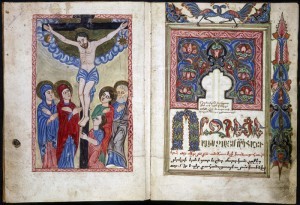



March 25, 2016
Pic of the Week: It’s Bloomin’ Time

Cherry blossoms reach peak bloom outside the Library’s Thomas Jefferson Building. Photo by Shawn Miller.
This week marks the beginning of the National Cherry Blossom Festival, an annual event held in Washington, D.C. to commemorate the gift of some 3,000 Yoshino cherry trees given to the city in 1912 as a symbol of friendship between Japan and the United States.
The grounds of the Library of Congress Thomas Jefferson Building are home to two of the original group, which are also among only nine remaining from the 1912 gift.
You can learn more about the local blossoms in this resource guide or through this video that presents highlights of the Library exhibition (now available online) “Sakura: Cherry Blossom as Living Symbols of Friendship.”
March 23, 2016
Congas, Sambas and Falling Plaster
Billy Joel (Credit: Columbia)
I was 15 years old, sitting cross-legged next to my friend Mascha on a cork-tile floor at Mammoth Gardens, a roller-skating rink built in 1910. Plaster, occasionally, was falling from the ceiling – because the band on the stage that night was the drum-heavy Santana, which had just released its 1970 album “Abraxas.” That’s the album with the breakout singles “Black Magic Woman,” “Oye Como Va” and the beautiful “Samba Pa Ti.”
What we thought was seriously cool then has held up pretty well. “Abraxas” has just been added to the Library of Congress National Recording Registry, which recognizes sound recordings worthy of permanent preservation on grounds they have cultural, artistic or historic importance. This year’s offerings also include Billy Joel’s single “Piano Man.”
“I am very honored to have my song, ‘Piano Man,’ included in the National Recording Registry by the Library of Congress,” said Joel. “While the recording of the album featured the now familiar song “Piano Man,’ some may not know that it was not initially a retail success. It was, however, considered a ‘turntable hit’, due to widespread airplay of various ‘album tracks’ by progressive FM radio stations around the country. Both the single and the album ‘Piano Man’ eventually went on to achieve ‘platinum’ status, thanks to that kind of free-form radio airplay.
“I personally owe a great deal of thanks to those independent disk jockeys who did not have to adhere to the restrictions of ‘program consultants’ and ‘hit formats’ as commercial radio does today,” added Joel (who received the Library’s Gershwin Prize for Popular Song two years ago). “They took the risk of broadcasting new and unproven music, based mostly on listener requests and their own enthusiasm for the recording artists of that time.”
The other recordings among this year’s 25 selections range from Gloria Gaynor’s “I Will Survive” to blues numbers, a landmark Zydeco album, a frenzied 1938 Mahler’s Ninth that foreshadowed Hitler’s invasion of Austria and the speech by U.S. Secretary of State George Marshall that kicked off the “Marshall Plan” that gave hope to citizens of the European nations devastated by World War II.
The registry also includes George Carlin’s icon-smashing “Class Clown,” the fourth quarter of Wilt “The Stilt” Chamberlain’s astounding 100-point basketball game in 1962; the LP in which Metallica stopped thrashing and took metal music in a new direction; and two variations on the song “Mack the Knife,” by Louis Armstrong and Bobby Darin.
(I had a boss once who used to deliberately botch the words of “Mack.” “Oh, the snark bites, with its feet, dear …” Try working on deadline with that distraction!)
Congress created the National Recording Registry (which now holds 450 designated recordings) to preserve these sounds of our times for posterity. You can nominate recordings of all kinds to become part of the registry, and you should. Here’s the link where you can have your say.
March 22, 2016
Ask Us Anything: Reddit AMA on Rosa Parks Papers 3/29
Rosa Parks, left, speaks with U.S. Rep. Shirley Chisholm
The following is a guest post by Library of Congress Information Technology Specialist Michelle Rago:
Library experts involved in making the papers of Rosa Parks available online will answer your questions in a Reddit “Ask Me Anything” (AMA) session beginning at 9 a.m. (ET) on March 29, 2016. Join us on the AskHistorians subreddit.
The collection contains some 7,500 manuscripts and 2,500 photographs. It is on loan to the Library for 10 years from the Howard G. Buffett Foundation.
Parks, an African American, made history on Dec. 1, 1955, when she refused to give up her seat to a white passenger on a segregated bus in Montgomery, Alabama. Parks’ arrest triggered the Montgomery Bus Boycott, a major event in the Civil Rights Movement. Parks died at age 92, in 2005.
The Rosa Parks collection brings forward many details of her life and personality, from her experiences as a child in the segregated South to her problems finding work after the Montgomery Bus Boycott and from her love for her husband to her activism on civil-rights issues.
During the Reddit AMA experts from the Library of Congress Manuscripts Division, the Prints & Photographs Division, and Educational Outreach will take your questions about Rosa Parks and about how the Library cataloged, preserved, digitized, and made her papers available to the world.
To participate in the AMA you must have a Reddit account. If you can’t make it to the session you can always send questions through our Ask a Librarian service.
March 16, 2016
Happy 265th James Madison!
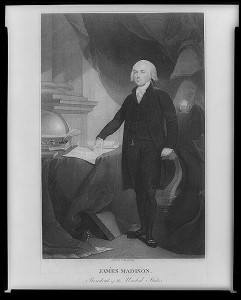
James Madison. Between 1809 and 1817. Prints and Photographs Division.
James Madison is known as the Father of the Constitution because of his pivotal role in the document’s drafting as well as its ratification. Madison also drafted the first 10 amendments — the Bill of Rights.
When the federal Constitution was approved by the states and went into effect in 1789, the absence of a Bill of Rights was the loudest and most effective criticism of it. Although he believed that individual rights were fully protected by the Constitution as it was ratified, Madison recognized that drafting a Bill of Rights was politically imperative.
His “Notes for a Speech on Constitutional Amendments,” June 8, 1789, highlights the arguments he used as a leader in the First Federal Congress to push 12 amendments to the Constitution through Congress in its first year. Ten of these amendments were ratified by the states and have been enshrined as the Bill of Rights.
The James Madison Papers are available online and consist of approximately 12,000 items that document the fourth president’s life through correspondence, personal notes, drafts of letters and legislation, an autobiography, legal and financial documents, and miscellaneous manuscripts.
For those interested in secret symbols, there is an essay on “James Madison’s Ciphers.” Madison, as a Virginia delegate to the Continental Congress, while he was secretary of state and in his personal correspondence with Jefferson, continually feared that unauthorized people would seek to read his private and public correspondence. To deter such intrusions, he resorted to a variety of codes and ciphers.
“The James Madison Papers” online presentation complements other online presidential papers from the Library of Congress, including George Washington, Thomas Jefferson, Abraham Lincoln, Andrew Jackson and James Monroe.
Madison was also the first to propose the idea of a congressional library in 1783. He later approved an act of Congress appropriating money to buy Jefferson’s book collection after the British burned the Capitol in 1814. You can read more about it in this Library of Congress blog post.
Pulitzer-prize winning historian Jack N. Rakove discusses Madison, his work and influence in this video.
{mediaObjectId:'FD3A32F1DBE2011EE0438C93F028011E',playerSize:'mediumStandard'}
Today the Library is convening a panel of scholars to discuss the fourth president’s early life, political and personal partnerships and his role at the 1787 convention. A video of the event will be made available in the coming weeks.
March 15, 2016
A Gorey Story
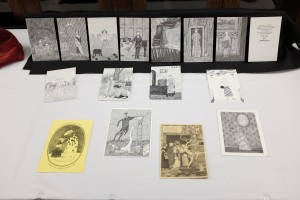
“Dogear Wryde Postcards: Neglected Murderesses Series,” 1980. Set 208 of 250, numbered and signed by Edward Gorey. Rare Book and Special Collections Division. Photo by Shawn Miller.
The work of Edward Gorey has often been described as “macabre,” a word that his friend Alexander Theroux claims the noted author and artist didn’t like. While I would agree that it’s an appropriate word, Gorey’s drawings are something more – odd, whimsical, humorous, magical, mysterious, gloomy, eccentric – all rolled up in delightful pen-and-ink sketches.
I was first introduced to Gorey’s work as a kid in the 1980s watching the long-running “Mystery!” series on PBS with my mom. The opening sequence was a wonderful animation featuring his work – a winking tombstone, a game of croquet in the rain, a blooming urn, a fainting lady losing her scarf. (You can see a version of the animation on PBS’s site).
Gorey passed away in 2000, but a collection of his work lives on at the Library. A gift from Gorey collector and enthusiast Glen Emil, the collection came to the Library’s Rare Book and Special Collections Division in December 2014 with quiet fanfare – probably how the artist himself would have wanted.
Emil began collecting Gorey-related material in 1979, which later became the foundation for the online portal Goreography.com. He donated the items to the Library in an effort to keep the collection “as a single unit, a testament to the appeal and popularity of Edward Gorey’s talent and his unremitting commitment to artistic expression in the literary world.”
Gorey created more than 100 works, including “The Gashlycrumb Tinies,” “The Doubtful Guest” and “The Wuggly Ump”; designed sets and costumes for theater productions from Cape Cod to Broadway, including Broadway’s “Dracula” for which he won a Tony; a remarkable number of illustrations in publications such as The New Yorker and The New York Times; and illustrations in books by a wide array of authors from Charles Dickens to Edward Lear, Samuel Beckett, John Updike, Virginia Woolf, H.G. Wells, Florence Heide and many others.
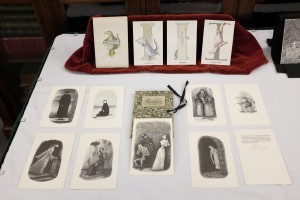
“Leaves from a Mislaid Album,” 1972. Set 19 of 50, numbered and signed by Edward Gorey. Rare Book and Special Collections Division. Photo by Shawn Miller.
The gift of the Goreyography.com collection introduced 802 items related to the American author and artist to the Library. This breaks down to 467 books, 89 periodicals, 92 posters and theater-related materials, 147 items of ephemera and seven works of art. There are also 25 items that can be described as reference documents: digitally recorded media programs and inter-office memos and communiqués. The collection is open to researchers and is accessible through the Rare Book and Special Collections Division Reading Room.
The collection is divided into three sections: works by Gorey, works with contributions by Gorey and, well, everything else.
Of the primary works by Gorey, items of note include two titles published and sold with original and unique artwork: “The Sopping Thursday” (1970) lettered edition with pen and ink artwork, and “Amphigorey” (1972), a numbered and signed copy with pen and ink with watercolor artwork. These are unique in that they are the only two primary section books that have original artwork that Gorey produced for sale.
According to Emil, the section containing Gorey’s contributions are some of his most popular and memorable work. “This is where Gorey’s impact upon the publishing industry is most obvious.” Most contributions were works for hire, but memorable examples include the John Bellairs and Brad Strickland gothic mystery novels for young adults, Anchor paperback designs from 1953 to about 1960, Marvin Kaye compilations for Doubleday, and mysterious stories by women writers edited by Seon Manley and Gogo Lewis for William Morrow.
The “everything else” section is probably the most fun and diverse of Gorey-related material. It includes original art, ephemera like dolls and theatrical promotion material. The Library now also has two limited copperplate etchings: “Dancing Elephant” (no. 34 of 75 and signed) and “Figbash” (no. 15 of 50 and signed).
“Part of Gorey’s charm is that he was a mysterious man,” said Emil. “He loved to say ‘What you see is what you get’ when asked what it all meant. He didn’t divulge meanings into his work and loved that people were engaged.”
Other sources: The Edward Gorey House, NPR
March 14, 2016
A Tale of Two Hebrew Patronesses
(The following post is by Ann Brener, Hebraic area specialist in the Library’s African and Middle Eastern Division.)
Every age has its own image of the “woman of valor,” and in the crumbling Jewish world of post-exilic Spain, that image was embodied in the persons of two unique women: Doña Gracia Nasi and Signora Benvenida Abravanel. Born into households “alike in dignity” and alike in influence and wealth, each of these women experienced the traumas of the exile from Spain, lived her life on the stage of international politics, and, ultimately, comes alive for us today in rare Hebrew books housed at the Library of Congress.
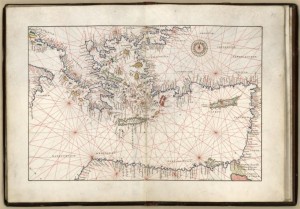
A map depicting the nautical charts of the Eastern Mediterranean in the middle of the 16th century. By Battista Agnese, 1544. Geography and Map Division.
The exile from Spain in 1492 and from Portugal in 1497 were not single events in the annals of Jewish history but rather milestones in a process of destruction, disruption and, above all, an ongoing search for a new home that, in many cases, lasted over several generations. The lives of both Gracia Nasi and Benvenida Abravanel are telling examples of these processes and of the political maneuverings they involved.
Members of the two most important Jewish families in Spain, each of these women was born into a matrix of wealth and power that led them to take leading roles in the struggle for Jewish survival in the aftermath of the exile. Nasi’s path led from Lisbon to Antwerp, Venice, Ferrara and finally to Istanbul, capital of the Ottoman Empire. Abravanel’s path was centered largely in Naples, but the two women crossed paths, albeit unknowingly, at many points on the compass of international politics, as well as in their generosity to fellow Jewish exiles and support of Jewish culture.
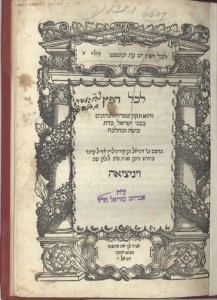
“Le-Khol Hefets,” by Eliezer Mili. Venice, 1552. African and Middle Eastern Division.
We do not know whether the two ladies ever met in person, but they do meet today on the shelves of the Library of Congress, through the books that their authors dedicated to their generous patronesses.
In an article published online in Jewish Women’s Archives, Howard Tzvi Adelman documents the good press enjoyed by Abravanel in contemporary Jewish literature; here in the Library of Congress we have evidence of her cultural patronage in a Hebrew book titled “Le-Khol Hefets” (“For Every Purpose”), published during her lifetime in 1552.
The book takes its name from a biblical verse: “For every purpose there is a time and a rule” (Ecclesiastes 3: 17), and as the title suggests it deals with the formal side of Jewish religious practice. With moving grace and notable alliteration, the author refers to Abravanel (“may her glory be exalted”) as “more perfect than all [other persons]”(“kulah kelulah min ha-kol”).
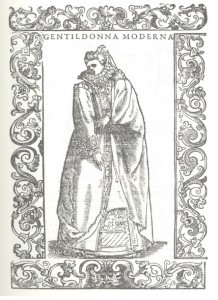
Illustration showing an elegantly dressed “modern noblewoman” of Naples from Signora Benvenida’s day. “Degli habiti, antichi et moderni di diversi parti del mondo” (Venice, 1590). Rare Book and Special Collections Division.
Like Abravanel, Nasi was known in her day as a patroness of Jewish culture; one contemporary writer called her quite simply “the heart of the body of the Portuguese nation” – the “Portuguese nation” being a kind of shorthand for the Jews forcibly converted in Spain and Portugal and now seeking to return to Judaism. The book was written in Portuguese, the mother-tongue of its author Samuel Usque, as well as most of the exiles.
Nasi’s daughter, Reyna, was the heir to her mother’s ideals as well as her wealth, and she, too, supported Jewish culture. Only in her case, the books she helped publish were in Hebrew rather than Portuguese, and she actually had the books printed in her own palace, Belvedere, using equipment that she herself commissioned. Of the 15 known books from her press (all exceedingly rare), five are now in the collections of the Library of Congress.
The books all bear similar information on the title page; the page shown here comes from a commentary on Genesis written by a rabbi visiting in Istanbul:

“Sefer Torat Moshe” (“The Book of the Teaching of Moses”),by Moses Alschich. Belvedere, ca. 1593. African and Middle Eastern Division.
“Printed in the home and with the letters of the illustrious lady, woman of valor, Doña Reyna Nasi, ‘may she be blessed above women in tents’ [Judges 5:24], widow of the prince and magnate in Israel, the lord Duke Don Joseph Nasi in her home here in Belvedere near the great city of Constantinople [i.e., Istanbul] under the rule of our lord the great and powerful Sultan Murad, may his glory be exalted.”
What books did Reyna choose to sponsor? Well, in addition to this commentary on Genesis, we find a commentary on the Book of Ruth and a volume of legal opinions by a local rabbi much admired in the Nasi circle. In his biography of Doña Nasi, the great scholar Cecil Roth deplores Reyna’s choices, dismissing the books as trivial works by local authors. Yet perhaps this judgment was over-harsh or misses the point altogether. By cultivating “local talent,” so to speak, Reyna Nasi may well have sought to create a living Hebrew culture in the best tradition of the great Jewish patrons who once lived in Spain and whose memory continued to inspire their descendants in exile.
March 11, 2016
Pic of the Week: Hedge Coke Honored as Witter Bynner Fellow

Witter Bynner Fellow Allison Hedge Coke reads from her work accompanied by musicians Laura Ortman and Kelvyn Bell. Photo by Shawn Miller.
On Wednesday, poet Allison Hedge Coke was honored as the 2016 Witter Bynner Fellow. She was selected and introduced by Poet Laureate Consultant in Poetry at the Library of Congress, Juan Felipe Herrera.
In his selection, Herrera said he sought to honor Hedge Coke “for her precision of Earth, of suffering in and out of the Rez, of the workers unnamed, open roads knitted with tin shacks, Case ’45 tractors, ancestor dust and the spirit tuned to caribou, America and song. For her translation projects of First Peoples across the entire hemisphere. For her unceasing teaching, humility, courage, and pioneering—for these offerings to the small miracles of all our voices and the galaxies they aim to call out and admire.”
In a statement, Coke said, “I am utterly grateful, thrilled, and deeply moved to be selected for the 2016 Witter Bynner Fellowship, stunned really, as it is by far the most humbling public moment of my life. Moreover, to be selected by such an immeasurably active Poet Laureate is just an immense honor.”
The Witter Bynner Foundation for Poetry was incorporated in 1972 in New Mexico to provide grant support for programs through non-profit organizations. Witter Bynner was an influential early-20th century poet and translator of the Chinese Classic “Tao Te Ching,” which he named “The Way of Life According to Laotzu.” He travelled with D.H. Lawrence and Frieda Lawrence and proposed to Edna St. Vincent Millay (she accepted, but then they changed their minds). He worked at McClure’s Magazine, where he published A.E. Housman for the first time in the United States, and was one of O. Henry’s early fans.
This is the 19th year that the fellowship has been awarded. You can view a list of all Witter Bynner Fellows here.
March 10, 2016
A Voice from Hoops History
(March Madness is right around the corner, and the Library of Congress has an interesting connection to basketball’s invention. The following is a story written by Mark Hartsell for the Gazette, the Library’s staff newsletter.)

A portrait of James Naismith, who in 1891 invented the game of basketball. New York World-Telegram and the Sun Newspaper Photograph Collection, Prints and Photographs Division.
Basketball, unique among major sports, has a clear creation story: We know when, where, why and how the game was invented, and by whom.
Now, some 125 years after the first game was played in a Massachusetts school gymnasium, we know something new: the sound of the creator’s voice.
A researcher recently discovered in the Library of Congress archives the only known audio recording of Dr. James Naismith – revealing, for the first time, the voice of the man who invented basketball, telling how he did it.
“Suddenly, out of nowhere, you have this very unique snapshot, kind of like putting your ear to the keyhole and hearing the past,” said Gene DeAnna, head of the Library’s Recorded Sound Section. “It’s really quite wonderful. There’s magic to it.”
The discovery was made by Michael J. Zogry, the director of indigenous studies and an associate professor of religious studies at the University of Kansas.
Zogry had been conducting research for a new book exploring the influence of Naismith’s religious beliefs on his work, including the invention of basketball.
“People tend to think of him as a sideline figure who created this game and that it kind of took off. But he was a very interesting person and he was a man of principle,” said Zogry, noting that Naismith declined to patent his game or try to get rich off it. “He lived those principles, he displayed those throughout his life – a great American success story.”
Seeking a Voice
Despite basketball’s great popularity in Naismith’s lifetime, no recorded interview with its inventor was known to exist. He appears in a least three films – all silent. Zogry, in the course of his research, had identified three potential audio recordings of interviews. Two leads were dead ends.
The third was a reference made in a Naismith biography to an interview on a popular radio program, “We the People,” in early 1939. Zogry was able to determine the broadcast date for that particular episode and eventually made an online reference request to the Recorded Sound Section.
The “We the People” recordings were part of the WOR-AM collection of radio programs donated to the Library on lacquer discs in 1984. The lacquer discs were transferred to tape and now are in the queue for digitization.
However, DeAnna said, many such collections come to the Library without in-depth cataloging – particularly variety shows such as “We the People.”
“The cataloging typically is pretty thin – usually the title of the show, the host and the date,” he said. “Beyond that, it’s difficult to analyze the content of these programs.”
In this case, the cataloging information didn’t include Naismith’s name. So, reference librarians in the Recorded Sound Research Center pulled the recording Zogry requested and heard history: Naismith describing, on the radio, the first basketball game ever played.
“I practically jumped – ‘My God, a recording of James Naismith,’ ” DeAnna said. “I had never heard that there was a recording of him, so it was pretty special.”
The Library provided the audio to Zogry, who soon had a special moment of his own: Zogry played the recording for Naismith’s 79-year-old grandson Jim Naismith – the first time he’d ever heard his grandfather’s voice.
“That was a terrific moment,” Zogry said.
Peach-Basket Ball
James Naismith had been working as a physical instructor at what is now Springfield College in Massachusetts during the winter of 1891, seeking something to occupy his students during a New England blizzard.
So, he nailed two peach baskets up at opposite ends of the gym floor, divided his charges into two teams of nine – sides would be reduced to five in later years – and told them the object of his new game: pass the ball up the court and throw the ball into the opposing team’s basket.
Naismith’s game, with modified rules, spread around the globe. The YMCA introduced basketball internationally by 1893, the first pro league formed in 1898, major colleges adopted the sport in the early 1900s and, in 1936, the Olympics added basketball as an official sport, with Naismith on hand to present the medals.
Three years later, Naismith went to New York in early January to attend a college basketball doubleheader at Madison Square Garden. While there, he submitted to the “We the People” interview with host Gabriel Heatter.
In the brief segment – the recording is about 2.5 minutes long – Naismith describes how he came up with the game and the first contest ever played.
Naismith quickly realized, he told Heatter, that he’d made a big mistake: This game seriously needed more rules.
“The boys began tackling, kicking and punching in the clinches. They ended up in a free-for-all in the middle of the gym floor,” Naismith said. “Before I could pull them apart, one boy was knocked out, several of them had black eyes, and one had a dislocated shoulder.
“It certainly was murder.”
The boys kept nagging Naismith to let them play again, so he sat down and wrote 13 basic rules that served as the foundation for how the game is played.
“The most important one was that there should be no running with the ball; that stopped tackling and slugging,” Naismith said. “We tried out the game with those rules, and we didn’t have one casualty – we had a fine, clean sport.”
No Brogue, New Mystery
The recording offered something of a surprise: “Accounts suggested he had something of a Scottish brogue,” Zogry said. “He sounded like an elderly gentleman from the Midwest.”
It also created a mystery: Previous accounts said that the rules were written before the first game, not after. Zogry suggests that Naismith, trying to please the show’s producers, might have been reading from a script, perhaps provided by the program.
“Whether he wrote what he said or someone else did, I think that he felt it was in the spirit of what he was trying to get across,” Zogry said.
Naismith died only 10 months after the interview, leaving a newly discovered recording that, Zogry said, helps reveal a modest and humble man who invented something great.
“In this day and age where media is ubiquitous,” Zogry said, “to be able to find something like this is extraordinary.”
Library of Congress's Blog
- Library of Congress's profile
- 74 followers



